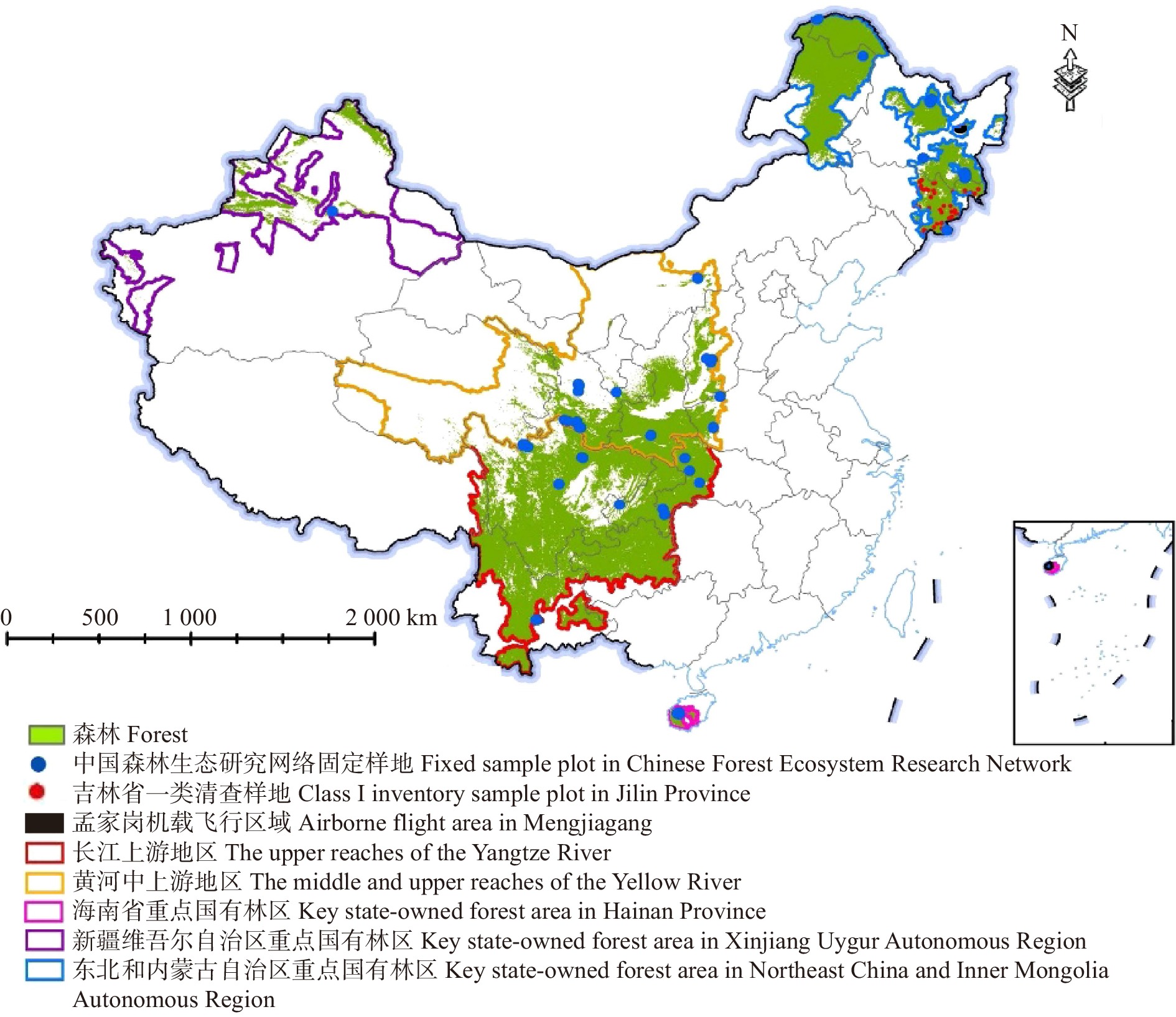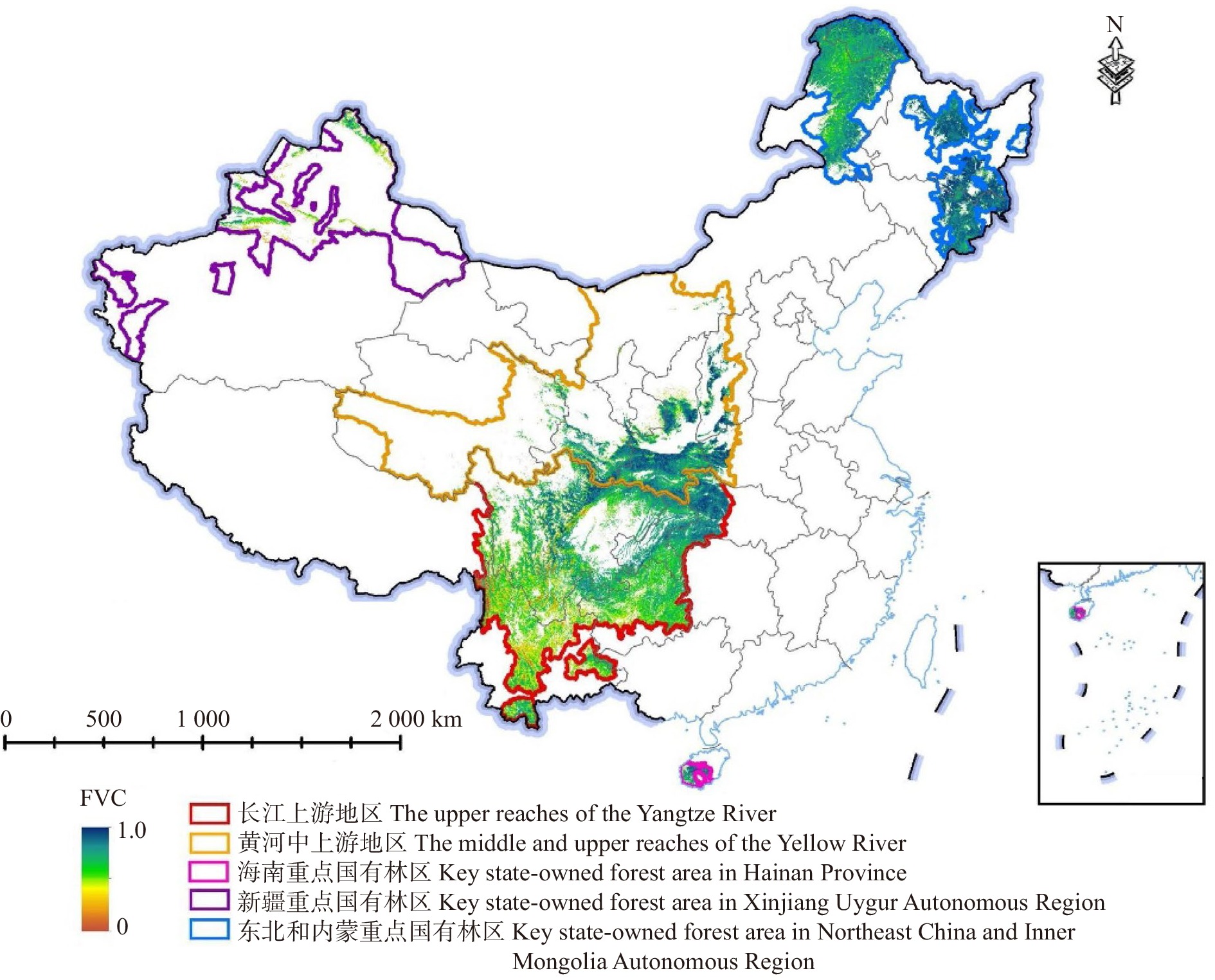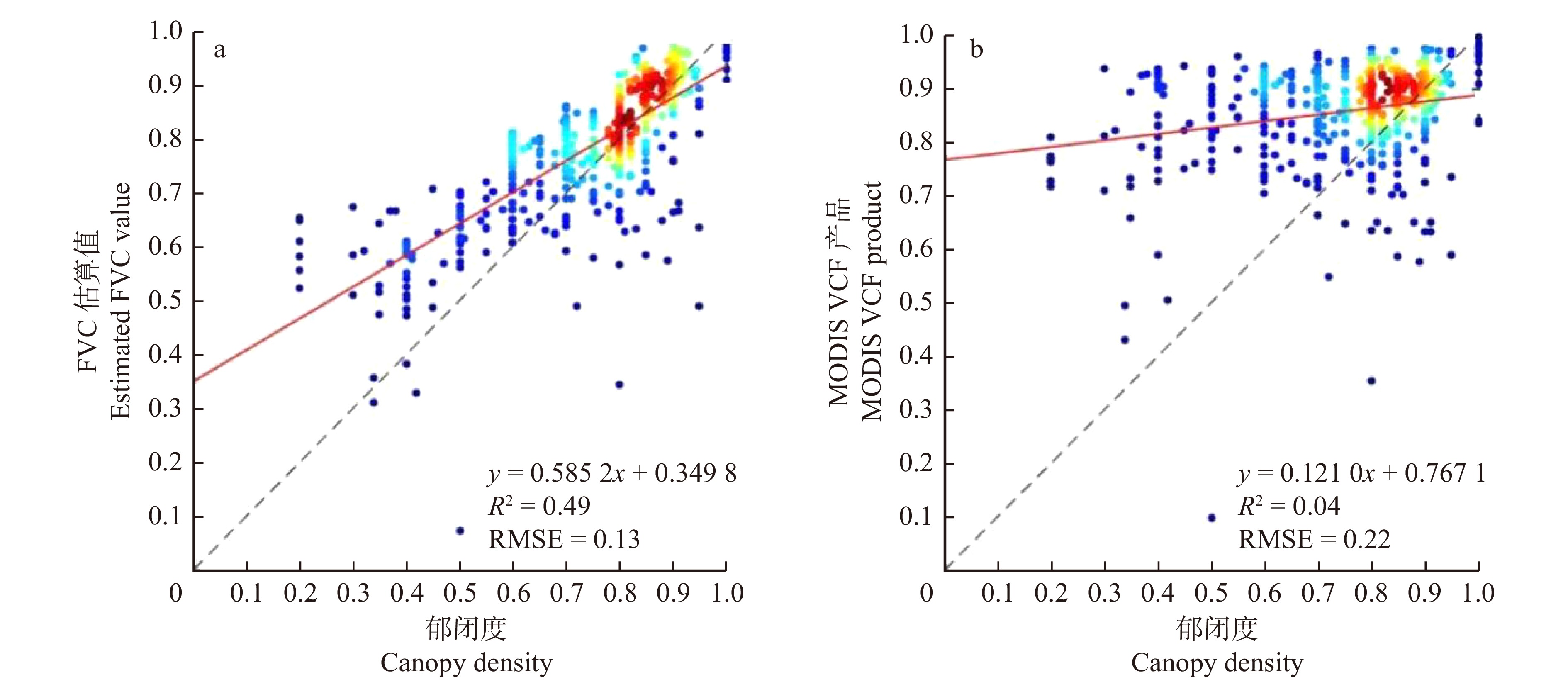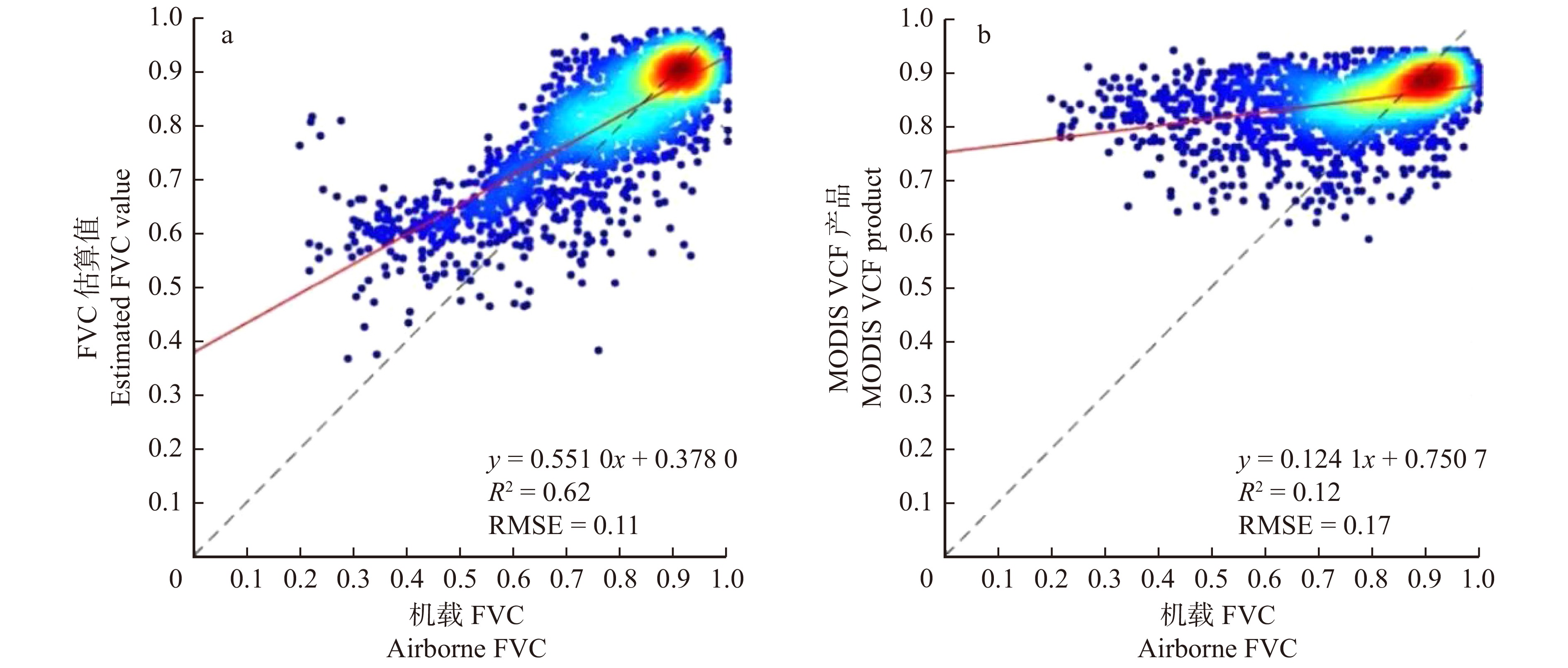Remote sensing estimation and change analysis of fractional vegetation coverage in Natural Forest Resource Protection Project area
-
摘要:目的 天然林资源保护工程(简称“天保工程”)实施20多年来有效保护和恢复了工程区的森林资源。工程实施成效除了森林覆盖面积增加,更多的表现为森林资源质量持续提升。为了更好地评估天保工程建设成效,利用植被覆盖度作为定量评价指标,分析天保一期(2000—2010年)、天保二期(2011—2020年)工程实施期间的森林质量变化。方法 综合年度植被指数合成策略、优化纯植被像元和纯裸土像元值域的动态确定方法,构建改进的像元二分模型,生产天保工程区时间序列的植被覆盖度产品。基于森林资源一类清查郁闭度数据、森林生态系统定位研究网络郁闭度数据、机载高光谱植被覆盖度数据,验证该植被覆盖度产品的精度。在此基础上,分析天保工程林区植被覆盖度的时空变化趋势。结果 天保一期植被覆盖度均值为0.68,天保二期植被覆盖度均值为0.71,增加了4.41%;工程区植被覆盖度呈现增加趋势的面积占林区总面积的78.22%,而呈减小趋势的面积仅占林区总面积的9.56%。结论 在中国天保工程森林地区,基于MODIS 植被指数产品和改进的像元二分模型生产的植被覆盖度产品的精度高于MODIS产品的精度。自天保工程实施以来,林区植被覆盖度总体上呈现出明显的增加趋势,说明天保工程实施效果显著,森林资源质量持续提升。Abstract:Objective The forest resources have been effectively protected and restored with the implement of Natural Forest Resource Protection Project (NFPP) in recent twenty years. In addition to a slight increase in forest coverage, effects of the project are mainly the continuous improvement of forest resource quality. To quantitatively assess the effects of NFPP, the fractional vegetation coverage (FVC) was used as the indicator to demonstrate the forest quality during the first stage (2000−2010) and second stage (2011−2020) of NFPP.Method A modified dimidiate pixel model was proposed based on the new vegetation index composition strategy and the dynamically determination method of the pure vegetation and soil pixels, and time series FVC was generated in the project area. FVC was then validated by forest resource inventory data, Chinese forest ecosystem research network data and airborne hyperspectral data. At last, the spatial and temporal variation of FVC was analyzed in NFPP area of China.Result FVC increased from 0.68 to 0.71 since the implement of the project. Area with increased FVC trend was about 78.22% of the total forest area, while area with decreased FVC trend only accounted for 9.56% of the total forest area.Conclusion Accuracy of the estimated FVC was higher than that of MODIS product. An obviously increasing trend of FVC could be found in the NFPP area, which indicates that the quality of forest is increasing since the implement of NFPP.
-
丛枝菌根真菌(arbuscular mycorrhiza fungi,AMF),作为一种与植物关系最为密切的微生物,广泛分布于地球,能与陆地上大约90%的植物产生共生关系[1]。AMF能够为植物提供一个良好的根际环境,并通过增进营养吸收、提高光合效率等多种途径,改善植物的生长发育,促进植物与生态系统的C、N、P循环,提高植物生长量。Wu等[2]研究表明,AMF定殖欧美杨107(Populus × euramericana ‘Neva’)可以显著提高其氮素吸收及光合作用。
植物可通过提高次生代谢产物含量、防御蛋白活性或者改变体内营养成分含量等一系列生理生化反应提高其化学防御能力,抵御植食性昆虫的危害[3]。植物次生代谢产物是非营养物质,能够增加昆虫的代谢负担、降低昆虫对食物的利用效率,进而影响其正常生长发育[4-5]。防御蛋白包括防御酶和蛋白酶抑制剂。防御酶是植物由初生代谢转为次生代谢途径中的关键酶,对降低植物的营养价值和毒害植食昆虫方面具有重要意义[6],主要包括苯丙氨酸解氨酶(PAL)和多酚氧化酶(PPO);蛋白酶抑制剂能削弱昆虫肠道内蛋白酶活性或阻断消化酶对食物中蛋白质的消化利用,还能诱导昆虫消化酶的过度分泌,造成昆虫营养不良,进而影响昆虫的生长[7]。尽管,植物体内营养物质的含量是衡量植物抗虫性的另一种生理指标[8],但是,营养物质与次生代谢产物和防御蛋白对抗虫性的调控机制并不一致,因为营养物质含量与抗虫性并不一定呈线性相关,主要取决于含碳、氮营养物质的比例[9-10]。大量研究表明,AMF作为一种生物制剂在与植物形成共生体后,会与植物进行复杂的信号分子交换并产生诱导因子,诱导激发植物的化学防御[11],在一定程度上诱导激发植物的抗病性、抗虫性或抗应激能力,间接提高植物对不利环境条件的适应性[12]。例如:异形根孢囊霉(Rhizophagus irregularis)定殖车前草(Plantago lanceolata)后,能显著提高其叶片中次生代谢产物梓醇的含量,使甜菜夜蛾(Spodoptera exigua)的死亡率显著升高[13]。Nishida等[14]研究显示,将日本百脉根(Lotus japonicus)分别接种根内球囊霉(Glomus intraradices,GI)、幼套近明球囊霉(Glomus etunicatum,GE)、聚丛球囊霉(Glomus aggregatum,GA)、稍长无梗囊霉(Acaulospora longula)、球状巨孢囊霉(Gigaspora margarita)或玫瑰红巨孢囊霉(Gigaspora rosea)6种AMF可以显著提高其叶片内酚类的含量,使二斑叶螨(Tetranychus urticae)的取食和产卵受到显著抑制。GI能通过茉莉酸途径诱导黄瓜(Cucumis sativus)产生防御性物质葫芦素C,使甜菜夜蛾的取食量显著低于对照[15]。
目前,关于AMF的研究,多以豆科植物或农业经济型植物的抗逆性为主,其对林木抗虫性影响的研究较少。本研究以银中杨(Populus alba × P. berolinensis)为对象,对其接种摩西球囊霉(Glomus mosseae,GM)或GI,在侵染率达到最高时,测定银中杨叶片N和P元素、营养物质、次生代谢产物含量和防御蛋白活性,分析AMF对银中杨物质代谢及化学防御的影响,为利用AMF诱导增强林木化学防御及提高林木抗虫性提供理论依据。
1. 材料与方法
1.1 试验材料
供试植物:1年生银中杨扦插苗。扦插前一周对插穗进行沙埋,并定期浇水。将插穗取出后,用500 mg/L生根粉溶液浸泡12 h后扦插。
供试菌剂:摩西球囊霉(GM)和根内球囊霉(GI)由甘肃农科院提供,通过宿主玉米和三叶草扩繁完成,菌剂中包含孢子、菌丝、根段和沙子,其中孢子含量15 个/g。
土壤:草炭土∶蛭石∶沙子 = 3∶1∶1,混合后在121 ℃下高压灭菌2 h。
1.2 试验设计
试验前,将高11.5 cm的32孔塑料穴盘和容量为1 L的花盆用0.3%KMnO4溶液浸泡2 h进行消毒处理。在穴盘内装入灭菌后的土壤。将浸泡后的插穗扦插于穴盘,每穴1株,定期浇水,一个月后移栽至花盆。将花盆分为3组,在AMF处理组的每个花盆中,分别装入1.3 kg灭菌土壤与20 g GM或GI的均匀混合物,对照组只装入1.3 kg灭菌土壤,不加菌剂。每盆移栽1株扦插苗,每组150株,3组共450株。移栽后,在东北林业大学林木遗传育种苗圃温室进行培养,并进行定期浇水除草。
1.3 指标测定
1.3.1 侵染率测定
根据Phillips等[16]方法修改。在移植后30、60、90和100 d,从每组随机各选取5株样树,检测AMF侵染率。将样树根部须根剪下,洗净,剪成1 ~ 2 cm长的小段,先加入10%KOH,放入90 ℃水浴锅加热30 min使根透明(溶液变黄要及时更换,直至溶液不再变黄)。根透明后用蒸馏水清洗3 ~ 5次,再加入20%过氧化氢使根软化,静置10 ~ 15 min,取出根用蒸馏水洗净;然后加入2%稀盐酸酸化5 min,用蒸馏水洗净,接着加入曲利苯蓝溶液(乳酸(mL)∶甘油(mL)∶曲利苯蓝(g) = 100∶100∶0.2)进行染色30 min。染色完成后用蒸馏水清洗两次,最后放入乳酸−甘油(1∶1)中脱色12 h,取出后置于乳酸甘油溶液(乳酸∶甘油∶水 = 1∶1∶1)中,4 ℃保存,蒸馏水清洗后取样镜检。通过网格线相交法[17]计算AMF侵染率,以根段上出现孢子或丛枝为标准。在每次取样时,每个样树至少观察50小段根样,每个处理共观察250小段根样。在侵染率达到最高时,取样测定叶片内营养元素、营养物质和次生代谢产物含量,以及防御蛋白活性。
1.3.2 N、P元素测定
每个处理组随机选取9株样树,每3株一个重复,测3个重复。每株选取第3、第4片子叶进行测定,下同。N元素采用奈氏比色法,测定P元素采用钼锑抗比色法[18]。
1.3.3 营养物质测定
可溶性蛋白质含量采用考马斯亮蓝法[19]测定,可溶性糖和淀粉含量采用蒽酮比色法[20]测定。
1.3.4 防御蛋白活性及次生代谢物质含量测定
PAL采用苯丙氨酸比色法[20],PPO采用邻苯二酚比色法[21]。TI和CI依据孟昭军[20]和段文昌等[22]方法测定。总酚采用福林酚比色法[23]测定,单宁依据范旭东[24]的方法测定,黄酮含量依据Jia等[25]的方法测定,木质素含量依据任琴等[26]的方法测定。
1.4 数据处理与分析
使用Excel2010统计数据的平均值和标准误差。使用SPSS22.0 one-way ANOVA进行差异显著性方差分析,多重比较采用LSD法在0.05水平下检验各组之间的差异显著性。
2. 结果与分析
2.1 GM和GI侵染率随时间的变化趋势
在处理30、60、90、100 d后GM和GI侵染率随时间变化如图1所示。随着处理时间的延长,侵染率呈显著升高,且GM和GI处理组之间差异显著(P < 0.05)。在30 d时,GM侵染率为10.8%,GI为15.6%;60 d时,GM为20.1%,GI为30.5%;在90 d时侵染率达到最大值,GM为45.6%,GI为61.7%;在100 d时侵染率降低,GM为43.7%,GI为60.8%。CK组没有检测到侵染。
![]() 图 1 GM、GI处理组侵染率随时间变化的趋势CK.对照;GM.摩西球囊霉;GI.根内球囊霉。数据均为平均值 ± 标准差(n = 3);不同小写字母表示处理组与对照组之间差异显著(P < 0.05)。下同。CK, control; GM, Glomus mosseae; GI, Glomus intraradices. The data annotation in the picture is average value ± SD (n = 3); different lowercase letters mean significant differences between treatment group and control group (P < 0.05). The same below.Figure 1. Trend of infection rate of GM and GI with time
图 1 GM、GI处理组侵染率随时间变化的趋势CK.对照;GM.摩西球囊霉;GI.根内球囊霉。数据均为平均值 ± 标准差(n = 3);不同小写字母表示处理组与对照组之间差异显著(P < 0.05)。下同。CK, control; GM, Glomus mosseae; GI, Glomus intraradices. The data annotation in the picture is average value ± SD (n = 3); different lowercase letters mean significant differences between treatment group and control group (P < 0.05). The same below.Figure 1. Trend of infection rate of GM and GI with time2.2 GM和GI处理叶片中N、P 及营养物质的含量
银中杨接种GM、GI 90 d后叶片内N、P及营养物质含量如图2所示。GM和GI处理组叶片N、P元素含量显著高于CK组(P < 0.05)。P元素含量,GI组显著高于GM组(P < 0.05);N元素含量,GM与GI组差异不显著(如图2A)。可溶性蛋白质含量,GM和GI处理组显著高于CK组(P < 0.05),GM和GI组间差异不显著;可溶性糖含量,GM和GI处理组显著低于CK组(P < 0.05),GM与GI处理组差异不显著;淀粉含量3组间差异均不显著(如图2B)。
2.3 GM和GI处理叶片中次生代谢产物的含量
接种GM、GI 90 d后,银中杨叶片内次生代谢产物含量如图3所示。总酚、黄酮、木质素和单宁含量,GM和GI处理组均显著高于CK组(P < 0.05)。在2个处理组间,木质素和单宁差异显著(P < 0.05),总酚和黄酮差异不显著(P > 0.05)。
2.4 GM和GI处理叶片中防御蛋白的活性
接种GM、GI 90 d后,银中杨叶片内防御蛋白苯丙氨酸解氨酶(PAL)、多酚氧化酶(PPO)、胰凝乳蛋白酶抑制剂(CI)和胰蛋白酶抑制剂(TI)的活性均显著大于对照(见图4)。在2个处理组间,PAL活性差异显著(见图4A),PPO、CI和TI活性差异不显著(见图4B、C、D)。
3. 结论与讨论
本研究表明,外源接种AMF(GM或GI)可以显著提高银中杨的物质代谢和化学防御,具体表现为叶片内N、P、可溶性蛋白质含量增加,可溶性糖含量减少,次生代谢产物含量增加,防御蛋白活性增强。
研究报道,GI可以改善欧美杨107对N、P的吸收和利用,其中N吸收与蛋白质的含量变化有关[2]。Tao等[27]研究显示,用不同浓度的GM、GI和GE混合菌种处理马利筋属(Asclepias)6种植株,能显著提高其根系和叶片内的N、P含量;随着P浓度的增加,马利筋生长速率显著加快,因而对黑脉金斑蝶(Danaus plexippus)危害的耐受性显著提高;同时N含量的增加使马利筋叶片的乳胶(主要防御物质)渗出量显著提高。用GM、GI和地表球囊霉(Glomus versiforme,GV)等3种AMF分别处理黄瓜,均可以在不同程度上显著提高其对土壤基质中N、P元素的吸收能力[28]。本研究结果进一步证实了这一点。N、P在植物生长过程中起到重要的生理作用,不仅可以提高植物叶片的营养水平,而且参与氮代谢和磷代谢等生理进程,进而提高植物的耐受性[29]。本试验显示,AMF处理组可溶性糖含量显著低于对照,淀粉含量差异不显著,其原因可能是植物碳素营养物质与AMF消耗植物糖类的水平有关[30]。Bonfante和Genre研究报道,在植物生长早期AMF会起到抑制作用,可能是由于真菌的生长需要寄主植物提供糖类[31]。相关研究[32]表明,接种GE和GM促进了柑橘幼苗叶片可溶性蛋白等的积累,提高了防御蛋白的活性,进而增强植物对干旱的适应能力。在我们的研究中,可溶性糖含量降低即碳素含量降低,氮素含量升高,碳氮比降低。据报道,植物体内的碳氮比是研究抗虫性的重要指标,碳氮比的高低对不同植物的抗虫性影响不同[33-34]。Gherlenda等[35]研究发现,高浓度的CO2条件下,细叶桉(Eucalyptus tereticornis)的C/N升高,对桉树龟金花虫(Paropsis atomaria)幼虫体重显著降低,血淋巴蛋白含量显著降低。马艳等[36]研究表明,在棉铃虫(Helicoverpa armigera)幼虫取食C/N低的棉花(Gossypium spp.)后,成虫产卵量增加,雄性成虫寿命显著增加。因此,本研究中银中杨碳氮比与抗虫性的关系有待我们进一步生物测定。
次生代谢产物含量和防御蛋白活性是衡量植物抗虫性的生理指标。分月扇舟蛾(Clostera anastomosis)危害69杨(P. deltoides)和895杨(P. delotides × P.euramericana cv.‘Nanlin895’)后,诱导杨树叶片内单宁、黄酮和总酚含量显著升高,延长分月扇舟蛾的幼虫期和蛹期,显著降低其化蛹率、蛹重、羽化率和产卵量 [37]。Jiang等[38]在研究茉莉酸诱导下长白落叶松(Larix olgensis)的抗虫机制时发现,针叶内防御蛋白酶和蛋白酶抑制剂活性的增加是抑制舞毒蛾(Lymantria dispar)生长发育的主要原因之一。本研究中,在接种AMF的银中杨叶片内,次生代谢产物总酚、黄酮、木质素和单宁的含量及防御蛋白PAL、PPO、CI和TI活性均显著高于对照,进一步说明AMF诱导可以提高银中杨的化学防御。相似的研究发现,接种GI的黑吉豆(Vigna mungo)叶片中积累大量的防御代谢产物,如酚类,木质素以及防御蛋白,大大降低了斜纹夜蛾(Spodoptera litura)的取食率[39]。接种不同浓度的GM、GI和GE混合菌种能够显著提高马利筋叶片内的次生代谢产物卡烯内酯含量,使黑脉金斑蝶的生长发育和繁殖(体重、取食量和产卵量)受到抑制[27]。本试验中AMF诱导银中杨化学防御的改变是否会增强银中杨的抗虫性,有待进一步生物测定来验证。
不同AMF对寄主植物的适应性不同[40],即不同的AMF和植物共生对植食昆虫的抗性有不同的影响。在本研究中,GI对银中杨的侵染率显著高于GM,说明GI对银中杨的适应性更强。接种GI的银中杨生长发育显著高于接种GM(另文发表),GI组P含量显著高于GM组,但GM组木质素、单宁含量和PAL活性显著高于GI组。因此,在实践中,可根据生产目的选取AMF菌种。
本试验结果说明AMF能够促进银中杨的物质代谢,增强树势,改善其耐受性;提高银中杨的化学防御,改变其抗虫性。但对抗虫性是否具有积极地意义,有待我们进一步的生物测定结果来验证,从而为之后关于AMF的研究奠定理论基础。
-
表 1 FVC趋势变化分级
Table 1 FVC trend change grading
Theil-Sen median趋势
Theil-Sen median trendMann-Kendall显著性检验Z值
Z value of Mann-Kendall significance test分类
Classification≥ 0.0005 ≥ 1.96 明显增加 Increasing obviously ≥ 0.0005 ≤ 1.96 轻微增加 Increasing slightly −0.0005 ~ 0.0005 ≤ 1.96 保持稳定 Maintain stable ≤ −0.0005 ≤ 1.96 轻微减小 Decreasing slightly ≤ −0.0005 ≥ 1.96 明显减小 Decreasing obviously 注:引自文献[33-34]。Note: Cited form reference [33-34]. 表 2 天保工程实施以来重点区域FVC变化趋势面积比率
Table 2 FVC trend area ratio in key areas since the implementation of NFPP
% 时间 Time 区域 Area 明显减小
Deceasing obviously轻微减小
Decreasing
slightly保持稳定
Maintain stable轻微增加
Increasing slightly明显增加
Increasing obviously天保一期(2000—2010年)
The first stage of NFPP (2000−2010)长江上游地区
The upper reaches of the Yangtze River0.97 20.90 7.50 56.47 14.17 黄河中上游地区
The upper and middle reaches of the Yellow River0.69 14.14 7.51 50.06 27.61 东北和内蒙古自治区重点国有林区
Key state-owned forest area in Northeast China
and Inner Mongolia Autonomous Region0.70 20.41 13.17 57.66 8.06 新疆维吾尔自治区重点国有林区
Key state-owned forest area in Xinjiang Uygur Autonomous Region7.73 17.10 27.96 44.74 2.47 海南省重点国有林区
Key state-owned forest area in Hainan Province1.58 22.36 10.26 52.18 13.63 天保工程区 NFPP area 1.03 20.35 9.31 55.10 14.21 天保二期
(2011—2020年)
The second stage of
NFPP (2011−2020)长江上游地区
The upper reaches of the Yangtze River0.92 20.54 8.48 56.61 13.45 黄河中上游地区
The upper and middle reaches of the Yellow River0.59 15.38 8.86 56.96 18.22 东北和内蒙古自治区重点国有林区
Key state-owned forest area in Northeast China
and Inner Mongolia Autonomous Region0.97 23.56 17.15 51.27 7.05 新疆维吾尔自治区重点国有林区
Key state-owned forest area in Xinjiang Uygur Autonomous Region3.22 15.66 29.57 46.74 4.81 海南省重点国有林区
Key state-owned forest area in Hainan Province3.09 24.93 10.22 50.52 11.25 天保工程区 NFPP area 0.96 21.07 11.30 54.66 12.00 天保实施以来(2000—2020年)
Since the implement of
NFPP (2000−2020)长江上游地区
The upper reaches of the Yangtze River0.90 7.88 9.12 32.92 49.19 黄河中上游地区
The upper and middle reaches of the Yellow River0.45 3.27 6.34 21.08 68.87 东北和内蒙古自治区重点国有林区
Key state-owned forest area in Northeast China
and Inner Mongolia Autonomous Region1.58 9.38 20.00 37.62 31.43 新疆维吾尔自治区重点国有林区
Key state-owned forest area in Xinjiang Uygur Autonomous Region3.91 7.27 34.31 40.68 13.84 海南省重点国有林区
Key state-owned forest area in Hainan Province3.86 9.98 12.05 32.34 41.77 天保工程区 NFPP area 1.43 8.13 12.22 32.31 45.91 -
[1] 庞勇, 蒙诗栎, 史锴源, 等. 中国天然林保护工程区森林覆盖遥感监测[J]. 生态学报, 2021, 41(13): 5080−5092. Pang Y, Meng S L, Shi K Y, et al. Forest coverage monitoring in the Natural Forest Protection Project area of China[J]. Acta Ecologica Sinica, 2021, 41(13): 5080−5092.
[2] Liu J, Coomes D A, Gibson L, et al. Forest fragmentation in China and its effect on biodiversity[J]. Biological Reviews, 2019, 94(5): 1636−1657. doi: 10.1111/brv.12519
[3] 李依璇, 朱清科, 石若莹, 等. 2000—2018年黄土高原植被覆盖时空变化及影响因素[J]. 中国水土保持科学, 2021, 19(4): 60−68. doi: 10.16843/j.sswc.2021.04.007 Li Y X, Zhu Q K, Shi R Y, et al. Spatial and temporal changes of vegetation cover and its influencing factors in the Loess Plateau from 2000 to 2018[J]. Science of Soil and Water Conservation, 2021, 19(4): 60−68. doi: 10.16843/j.sswc.2021.04.007
[4] 李美丽, 尹礼昌, 张园, 等. 基于MODIS-EVI的西南地区植被覆盖时空变化及驱动因素研究[J]. 生态学报, 2021, 41(3): 1138−1147. Li M L, Yin L C, Zhang Y, et al. Spatio-temporal dynamics of fractional vegetation coverage based on MODIS-EVI and its driving factors in Southwest China[J]. Acta Ecologica Sinica, 2021, 41(3): 1138−1147.
[5] 李超, 罗栋梁, 李雪梅, 等. 2000—2018年天山植被生态质量综合评价[J]. 兰州大学学报 (自然科学版), 2021, 57(4): 528−536. Li C, Luo D L, Li X M, et al. A comprehensive evaluation of the vegetation ecology quality from 2000 to 2018 in the Tianshan Mountains[J]. Journal of Lanzhou University (Natural Sciences), 2021, 57(4): 528−536.
[6] 刘世荣, 庞勇, 张会儒, 等. 中国天然林资源保护工程综合评价指标体系与评估方法[J]. 生态学报, 2021, 41(13): 5067−5079. Liu S R, Pang Y, Zhang H R, et al. Evaluation indicator system and method designed for Natural Forest Protection Program of China[J]. Acta Ecologica Sinica, 2021, 41(13): 5067−5079.
[7] 闫敏, 李增元, 陈尔学, 等. 内蒙古大兴安岭根河森林保护区植被覆盖度变化[J]. 生态学杂志, 2016, 35(2): 236−243. doi: 10.13292/j.1000-4890.201602.033 Yan M, Li Z Y, Chen E X, et al. Vegetation fractional coverage change in Daxinganling Genhe Forest Reserve of Inner Mongolia[J]. Chinese Journal of Ecology, 2016, 35(2): 236−243. doi: 10.13292/j.1000-4890.201602.033
[8] 李钰溦, 贾坤, 魏香琴, 等. 中国北方地区植被覆盖度遥感估算及其变化分析[J]. 国土资源遥感, 2015, 27(2): 112−117. Li Y W, Jia K, Wei X Q, et al. Fractional vegetation cover estimation in northern China and its change analysis[J]. Remote Sensing for Land & Resources, 2015, 27(2): 112−117.
[9] 郑树峰, 王丽萍, 臧淑英. 大兴安岭天保工程区生态系统服务变化研究[J]. 地理科学, 2021, 41(7): 1295−1302. doi: 10.13249/j.cnki.sgs.2021.07.020 Zheng S F, Wang L P, Zang S Y, et al. The change of ecosystem services of natural forest protection project regions in the Da Hinggan Mountains[J]. Scientia Geographica Sinica, 2021, 41(7): 1295−1302. doi: 10.13249/j.cnki.sgs.2021.07.020
[10] Amarnath G, Babar S, Murthy M S R. Evaluating MODIS-vegetation continuous field products to assess tree cover change and forest fragmentation in India: a multi-scale satellite remote sensing approach[J]. The Egyptian Journal of Remote Sensing and Space Science, 2017, 20(2): 157−168. doi: 10.1016/j.ejrs.2017.05.004
[11] DiMiceli C, Townshend J, Carroll M, et al. Evolution of the representation of global vegetation by vegetation continuous fields[J/OL]. Remote Sensing of Environment, 2021, 254: 112271[2022−08−02]. https://doi.org/10.1016/j.rse.2020.112271.
[12] Majasalmi T, Rautiainen M. Representation of tree cover in global land cover products: Finland as a case study area[J]. Environmental Monitoring and Assessment, 2021, 193(3): 1−19.
[13] Gao Y, Ghilardi A, Paneque-Galvez J, et al. Validation of MODIS vegetation continuous fields for monitoring deforestation and forest degradation: two cases in Mexico[J]. Geocarto International, 2016, 31(9): 1019−1031. doi: 10.1080/10106049.2015.1110205
[14] Adzhar R, Kelley D I, Dong N, et al. MODIS vegetation continuous fields tree cover needs calibrating in tropical savannas[J]. Biogeosciences, 2022, 19(5): 1377−1394. doi: 10.5194/bg-19-1377-2022
[15] Adzhar R, Kelley D I, Dong N, et al. Assessing MODIS vegetation continuous fields tree cover product (collection 6): performance and applicability in tropical forests and savannas[J]. Biogeosciences Discussions, 2021, 1: 1−20.
[16] Yang X, Crews K. Applicability analysis of MODIS tree cover product in Texas savanna[J]. International Journal of Applied Earth Observation and Geoinformation, 2019, 81: 186−194. doi: 10.1016/j.jag.2019.05.003
[17] Tang H, Armston J, Hancock S, et al. Characterizing global forest canopy cover distribution using spaceborne lidar [J/OL]. Remote Sensing of Environment, 2019, 231: 111262 [2022−08−02]. https://doi.org/10.1016/j.rse.2019.111262.
[18] Fagan M E. A lesson unlearned? Underestimating tree cover in drylands biases global restoration maps[J]. Global Change Biology, 2020, 26(9): 4679−4690. doi: 10.1111/gcb.15187
[19] Yu T, Ni W, Zhang Z, et al. Regional sampling of forest canopy covers using UAV visible sereoscopic imagery for assessment of satellite-based products in Northeast China[J/OL]. Journal of Remote Sensing, 2022, 1−14[2022−12−02]. https://spj.science.org/doi/pdf/10.34133/2022/9806802.
[20] Gross D, Achard F, Dubois G, et al. Uncertainties in tree cover maps of Sub-Saharan Africa and their implications for measuring progress towards CBD Aichi Targets[J]. Remote Sensing in Ecology and Conservation, 2018, 4(2): 94−112. doi: 10.1002/rse2.52
[21] Gutman G, Ignatov A. The derivation of the green vegetation fraction from NOAA/AVHRR data for use in numerical weather prediction models[J]. International Journal of Remote Sensing, 1998, 19(8): 1533−1543. doi: 10.1080/014311698215333
[22] 贾坤, 姚云军, 魏香琴, 等. 植被覆盖度遥感估算研究进展[J]. 地球科学进展, 2013, 28(7): 774−782. doi: 10.11867/j.issn.1001-8166.2013.07.0774 Jia K, Yao Y J, Wei X Q, et al. A review on fractional vegetation cover estimation using remote sensing[J]. Advance in Earth Science, 2013, 28(7): 774−782. doi: 10.11867/j.issn.1001-8166.2013.07.0774
[23] Yang Y, Wu T, Zeng Y, et al. An adaptive-parameter pixel unmixing method for mapping evergreen forest fractions based on time-series NDVI: a case study of Southern China[J/OL]. Remote Sensing, 2021, 13(22): 4678[2022−08−02]. https://doi.org/10.3390/rs13224678.
[24] Jia K, Yang L, Liang S, et al. Long-term global land surface satellite (GLASS) fractional vegetation cover product derived from MODIS and AVHRR data[J]. IEEE Journal of Selected Topics in Applied Earth Observations and Remote Sensing, 2018, 12(2): 508−518.
[25] Ramon S R, Didan K, Jacobson A, et al. Modis vegetation index user’s guide[R/OL]. Tucson: 2010[2022−08−02]. https://lpdaac.usgs.gov/products/mod13q1v006/.
[26] Townshend J, Hansen M, Carroll M, et al. User guide for the MODIS vegetation continuous fields product collection 5 version 1[R/OL]. Maryland: 2011[2022−08−02]. https://modis.gsfc.nasa.gov/data/dataprod/mod44.php.
[27] Pang Y, Li Z, Ju H, et al. LiCHy: the CAF’s LiDAR, CCD and hyperspectral integrated airborne observation system[J/OL]. Remote Sensing, 2016, 8(5): 398[2022−08−02]. https://doi.org/10.3390/rs8050398.
[28] 庞勇, 梁晓军, 荚文, 等. 塞罕坝林场机载综合遥感实验[J]. 遥感学报, 2021, 25(4): 904−917. doi: 10.11834/jrs.20210222 Pang Y, Liang X J, Jia W, et al. The comprehensive airborne remote sensing experiment in Saihanba Forest Farm[J]. National Remote Sensing Bulletin, 2021, 25(4): 904−917. doi: 10.11834/jrs.20210222
[29] Jia W, Pang Y, Tortini R, et al. A kernel-driven BRDF approach to correct airborne hyperspectral imagery over forested areas with rugged topography[J/OL]. Remote Sensing, 2020, 12(3): 432[2022−08−02]. https://doi.org/10.3390/rs12030432.
[30] Rahman A F, Cordova V D, Gamon J A, et al. Potential of MODIS ocean bands for estimating CO2 flux from terrestrial vegetation: a novel approach[J]. Geophysical Research Letters, 2004, 31(10): 1−4.
[31] Gholamnia M, Khandan R, Bonafoni S, et al. Spatiotemporal analysis of MODIS NDVI in the semi-arid region of Kurdistan (Iran)[J/OL]. Remote Sensing, 2019, 11(14): 1723[2022−08−02]. https://doi.org/10.3390/rs11141723.
[32] Vanella D, Consoli S, Ramírez-Cuesta J M, et al. Suitability of the MODIS-NDVI time-series for a posteriori evaluation of the Citrus tristeza virus epidemic[J/OL]. Remote Sensing, 2020, 12(12): 1965[2022−08−02]. https://doi.org/10.3390/rs12121965.
[33] Shi P, Hou P, Gao J, et al. Spatial-temporal variation characteristics and influencing factors of vegetation in the Yellow River Basin from 2000 to 2019[J/OL]. Atmosphere, 2021, 12(12): 1576[2022−08−02]. https://doi.org/10.3390/atmos13060962.
[34] 方利, 王文杰, 蒋卫国, 等. 2000 ~ 2014 年黑龙江流域 (中国) 植被覆盖时空变化及其对气候变化的响应[J]. 地理科学, 2017, 37(11): 1745−1754. Fang L, Wang W J, Jiang W G, et al. Spatio-temporal variations of vegetation cover and its responses to climate change in the Heilongjiang Basin of China from 2000 to 2014[J]. Scientia Geographica Sinica, 2017, 37(11): 1745−1754.
[35] 相恒星, 王宗明, 毛德华. 东北地区天然林资源保护工程生态保护成效分析[J]. 中国科学院大学学报, 2021, 38(3): 314−322. doi: 10.7523/j.issn.2095-6134.2021.03.004 Xiang H X, Wang Z M, Mao D H. Ecological effect of Natural Forest Protection Project in Northeast China[J]. Journal of University of Chinese Academy of Sciences, 2021, 38(3): 314−322. doi: 10.7523/j.issn.2095-6134.2021.03.004
[36] 钱琛, 陈海滨, 侯现慧. 生态建设背景下陕西省植被覆盖时空变化及其影响因素研究[J]. 干旱区地区, 2020, 43(2): 425−433. Qian C, Chen H B, Hou X H. Temporal and spatial variation of vegetation cover and its influencing factors in Shaanxi Province in the context of ecological construction[J]. Arid Land Geography, 2020, 43(2): 425−433.
[37] 陈巧, 陈永富, 鞠洪波. 基于3S技术的天保区植被变化监测方法研究[J]. 林业科学研究, 2013, 26(6): 736−743. doi: 10.13275/j.cnki.lykxyj.2013.06.011 Chen Q, Chen Y H, Ju H B. Vegetation change monitoring for the natural forest protection based on spatial analysis techniques[J]. Forest Research, 2013, 26(6): 736−743. doi: 10.13275/j.cnki.lykxyj.2013.06.011
[38] 郑朝菊, 曾源, 赵玉金, 等. 近15年中国西南地区植被覆盖度动态变化[J]. 国土资源遥感, 2017, 29(3): 128−136. Zheng C J, Zeng Y, Zhao Y J, et al. Monitoring and dynamic analysis of fractional vegetation cover in southwestern China over the past 15 years based on MODIS data[J]. Remote Sensing for Land & Resources, 2017, 29(3): 128−136.
[39] 陶蕴之, 吕一河, 李凤全, 等. 西南天然林保护工程区生态成效评估[J]. 生态与农村环境学报, 2016, 32(5): 716−723. doi: 10.11934/j.issn.1673-4831.2016.05.005 Tao Y Z, Lü Y H, Li F Q, et al. Assessment of ecological effect on the natural forest protection project in southwest China[J]. Jouranl of Ecology and Rural Environment, 2016, 32(5): 716−723. doi: 10.11934/j.issn.1673-4831.2016.05.005
[40] Gitelson A A, Kaufman Y J, Stark R, et al. Novel algorithms for remote estimation of vegetation fraction[J]. Remote Sensing of Environment, 2002, 80: 76−87. doi: 10.1016/S0034-4257(01)00289-9
[41] 陈晋, 陈云浩, 何春阳, 等. 基于土地覆盖分类的植被覆盖率估算亚像元模型与应用[J]. 遥感学报, 2001, 5(6): 416−422. doi: 10.11834/jrs.20010603 Chen J, Chen Y H, He C Y, et al. Sub-pixel model for vegetation fraction estimation based on land cover classification[J]. Journal of Remote Sensing, 2001, 5(6): 416−422. doi: 10.11834/jrs.20010603
[42] Xiao J, Moody A. A comparison of methods for estimating fractional green vegetation cover within a desert-to-upland transition zone in central New Mexico, USA[J]. Remote Sensing of Environment, 2005, 98(2−3): 237−250.
[43] Kimes D S, Knyazikhin Y, Privette J L, et al. Inversion methods for physically-based models[J]. Remote Sensing Reviews, 2000, 18: 381−439. doi: 10.1080/02757250009532396
[44] Bacour C, Baret F, Béal D, et al. Neural network estimation of LAI, fAPAR, fCover and LAI Cab, from top of canopy MERIS reflectance data: principles and validation[J]. Remote Sensing of Environment, 2006, 105: 313−325. doi: 10.1016/j.rse.2006.07.014
[45] Xiao Z, Wang T, Liang S, et al. Estimating the fractional vegetation cover from GLASS leaf area index product[J/OL]. Remote Sensing, 2016, 8(4): 337[2022−08−02]. https://doi.org/10.3390/rs8040337.
[46] 李攀, 胡德勇, 赵文吉. 北方农牧交错带植被覆盖变化遥感监测研究−以河北省沽源县为例[J]. 国土资源遥感, 2010, 22(2): 113−117. Li P, Hu D Y, Zhao W J. The monitoring of changes of land vegetation covers by remote sensing in farming-pastoral mixedzones of North China: a case study in Guyuan County, Hebei Province[J]. Remote Sensing for Natural Resources, 2010, 22(2): 113−117.
[47] 张成才, 娄洋, 李颖, 等. 基于像元二分模型的伏牛山地区植被覆盖度变化[J]. 水土保持研究, 2020, 27(3): 301−307. doi: 10.13869/j.cnki.rswc.2020.03.043 Zhang C C, Lou Y, Li Y, et al. Change of vegetation coverage in Funiu Mountain Regions based on the dimidiate pixel model[J]. Research of Soil and Water Conservation, 2020, 27(3): 301−307. doi: 10.13869/j.cnki.rswc.2020.03.043
[48] 廖春华, 张显峰, 孙权, 等. 基于HJ-1高光谱数据的植被覆盖度估测方法研究[J]. 遥感信息, 2011(5): 65−70. doi: 10.3969/j.issn.1000-3177.2011.01.013 Liao C H, Zhang X F, Sun Q, et al. Fractional vegetation cover estimation using HJ-1 spaceborne hyperspectral data[J]. Remote Sensing Information, 2011(5): 65−70. doi: 10.3969/j.issn.1000-3177.2011.01.013
[49] 江淼, 张显峰, 孙权, 等. 不同分辨率影像反演植被覆盖度的参数确定与尺度效应分析[J]. 武汉大学学报(信息科学版), 2011, 36(3): 311−315. Jiang M, Zhang X F, Sun Q, et al. Vegetation coverage retrieval scale effect analysis using multi-sensor data[J]. Geomatics and Information Science of Wuhan University, 2011, 36(3): 311−315.
[50] 孟浩斌, 周启刚, 李明慧, 等. 基于MODIS像元尺度的三峡库区植被覆盖度变化的地形分布特征[J]. 长江流域资源与环境, 2020, 29(8): 1790−1799. Meng H B, Zhou Q G, Li M H, et al. Topographic distribution characteristics of vegetation cover change in the Three Gorges Reservoir Area based on MODIS pixel scale[J]. Resources and Environment in the Yangtze Basin, 2020, 29(8): 1790−1799.
[51] 赵威成, 马福义, 吕利娜, 等. 基于DVI的像元二分模型反演植被覆盖度研究[J]. 黑龙江科技大学学报, 2020, 30(2): 125−128. doi: 10.3969/j.issn.2095-7262.2020.02.002 Zhao W C, Ma F Y, Lü L N, et al. Study on inversion of FVC based on DVI pixel dichotomous model[J]. Journal of Heilongjiang University of Science and Technology, 2020, 30(2): 125−128. doi: 10.3969/j.issn.2095-7262.2020.02.002
[52] 庞国伟, 杨勤科, 王春梅, 等. 像元二分模型参数确定方法对高分一号 PMS 数据估算植被覆盖度精度的影响[J]. 地理与地理信息科学, 2019, 35(4): 27−33. doi: 10.3969/j.issn.1672-0504.2019.04.005 Pang G W, Yang Q K, Wang C M, et al. Influence of parameter determination methods of the pixel dichotomy model on the estimation accuracy of fractional vegetation cover by GF-1 PMS data[J]. Geography and Geo-Information Science, 2019, 35(4): 27−33. doi: 10.3969/j.issn.1672-0504.2019.04.005
[53] 丹宇卓, 石晶明, 李心怡, 等. 基于改进的像元二分模型估测郁闭度[J]. 北京林业大学学报, 2019, 41(6): 35−43. doi: 10.13332/j.1000-1522.20180263 Dan Y Z, Shi J M, Li X Y, et al. Estimation of canopy closure based on improved dimidiate pixel model[J]. Journal of Beijing Forestry University, 2019, 41(6): 35−43. doi: 10.13332/j.1000-1522.20180263
[54] Yan K, Gao S, Chi H, et al. Evaluation of the vegetation-index-based dimidiate pixel model for fractional vegetation cover estimation[J]. IEEE Transactions on Geoscience and Remote Sensing, 2021, 60: 1−14.
[55] Guo B, Han F, Jiang L. An improved dimidiated pixel model for vegetation fraction in the Yarlung Zangbo River Basin of Qinghai-Tibet Plateau[J]. Journal of the Indian Society of Remote Sensing, 2018, 46(2): 219−231. doi: 10.1007/s12524-017-0692-8
-
期刊类型引用(5)
1. 李娜娜,张冬冬,李鑫,刘小东,李海江,李宜璇. 放牧强度对草地丛枝菌根真菌多样性的影响. 现代畜牧科技. 2025(02): 85-89 .  百度学术
百度学术
2. 王琪,马宇佳,赵佳齐,严善春. 从枝菌根真菌对青山杨生长及其物质代谢的影响. 林业科技. 2024(05): 36-42 .  百度学术
百度学术
3. 邓薪岐,王谢,严晓军,柯佳君,杨叶,李艳,徐丹萍,卓志航,严贤春. 转录组和代谢组在林木真菌病害防御反应中的应用研究进展. 世界林业研究. 2022(04): 27-32 .  百度学术
百度学术
4. 方静,武帅,姜礅,谭明涛,赵佳齐,孟昭军,严善春. 丛枝菌根真菌定殖银中杨对舞毒蛾幼虫食物利用及适应性的影响. 菌物学报. 2022(12): 2016-2024 .  百度学术
百度学术
5. 张守攻. 林木重要性状形成的分子基础研究进展. 中国农业科技导报. 2022(12): 48-58 .  百度学术
百度学术
其他类型引用(8)




 下载:
下载:













